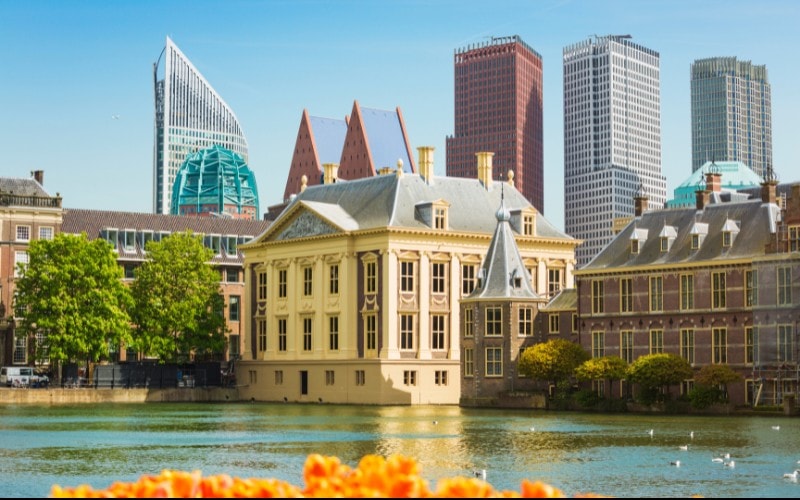The Hague’s Best Museums: Mauritshuis and Escher in the Palace
Artsy Traveler contains affiliate links for products and services I personally use and can happily recommend. As an Amazon Associate, I earn from qualifying purchases. Please read the Disclosure for more information. If you make a purchase through these links, at no additional cost to you, Artsy Traveler earns a small commission. Thank you!
lf you love art, visit The Hague to tour two excellent museums—the Mauritshuis and M. C. Escher in the Palace. The museums are within a few minutes’ walk of each other and easily toured in an afternoon.
Drop into The Hague for a quick visit en route to elsewhere in The Netherlands, or stay the night. I chose to spend the night, which gave me the chance to wander around the mostly deserted (but safe) streets after dark.
This post describes some of my favorite exhibits in the two museums and includes recommendations for places to stay in The Hague and tours to nearby attractions.
The Hague Overview
The Hague (AKA Den Haag) is not a heavily touristed city, certainly not on the level of Amsterdam with its canals and gift shops and hordes of visitors. Instead, The Hague consists of ultra-modern skyscrapers and a compact oldish section with a smattering of outdoor cafés and an attractive wide canal that features a fountain.
On your way to the two museums, you’ll stroll through the park that lines the canal across from which is a palace. Most of the people you’ll encounter will be locals, many relaxing on the benches and enjoying the sunshine on clear days.
I visited in early April when the air was chilly enough to need a scarf and the planters bristled with daffodils and tulips, but the sky was blue and the vibe very relaxed.
At the end of the canal sits the lovely Mauritshuis, an exquisite example of Dutch architecture. To the left of the Mauritshuis, a short stroll through the park, is Escher in the Palace.
Mauritshuis
The Mauritshuis in The Hague is truly world-class. I’d go so far as to say its collection of Dutch and Flemish masterpieces is even more compelling than that of the Rijksmuseum in Amsterdam. The collections are certainly a lot more accessible and easier to enjoy.
I love the Rijksmuseum, but its Gallery of Honor, where the most famous paintings are located, is so crowded that you sometimes need to wait for quite a while before you can get close enough to admire a particular masterpiece.
Not so at the Mauritshuis. The elegant building dates from the 17th century and was once the home of Count Johan Maurits of Nassau-Siegen who was the governor of the Dutch colony in Brazil. The museum’s name, “Mauritshuis”, translates to “Maurits’s house.” The building was established as a museum in 1822, and then extensively renovated and expanded over the years.
Entering the Mauritshuis Museum
You realize the Mauritshuis is special from the moment you enter. Descend a staircase (or take the elevator) from street level to emerge into a large and airy foyer complete with gift shop (of course) and ticket office.
The museum has recently undergone a face lift, and you get the feeling that everything is state-of-the-art. The museum’s website (https://www.mauritshuis.nl/en) bears this out; it’s a wonderful resource to accompany your visit to the museum.
Getting Tickets to Mauritshuis
I’d purchased a ticket in advance and I recommend you do as well. When I arrived about half an hour before the time on my ticket, there was no lineup to buy on-the-day tickets, but by the time I left, the lineup was quite long. To be on the safe side, go with tickets.
You can purchase tickets directly from the museum’s website or through GetYourGuide. Here’s an option:
Favorite Works at Mauritshuis
With ticket in hand, mount the stairs from the below-street-level foyer to the ground floor of the museum, which features exhibits related to the first owner. The house itself has been beautifully renovated, so you feel like you’re not only checking out an awesome collection from the Golden Age of Flemish masterpieces, but also getting an idea of what a 17th-century Dutch mansion looked like inside.
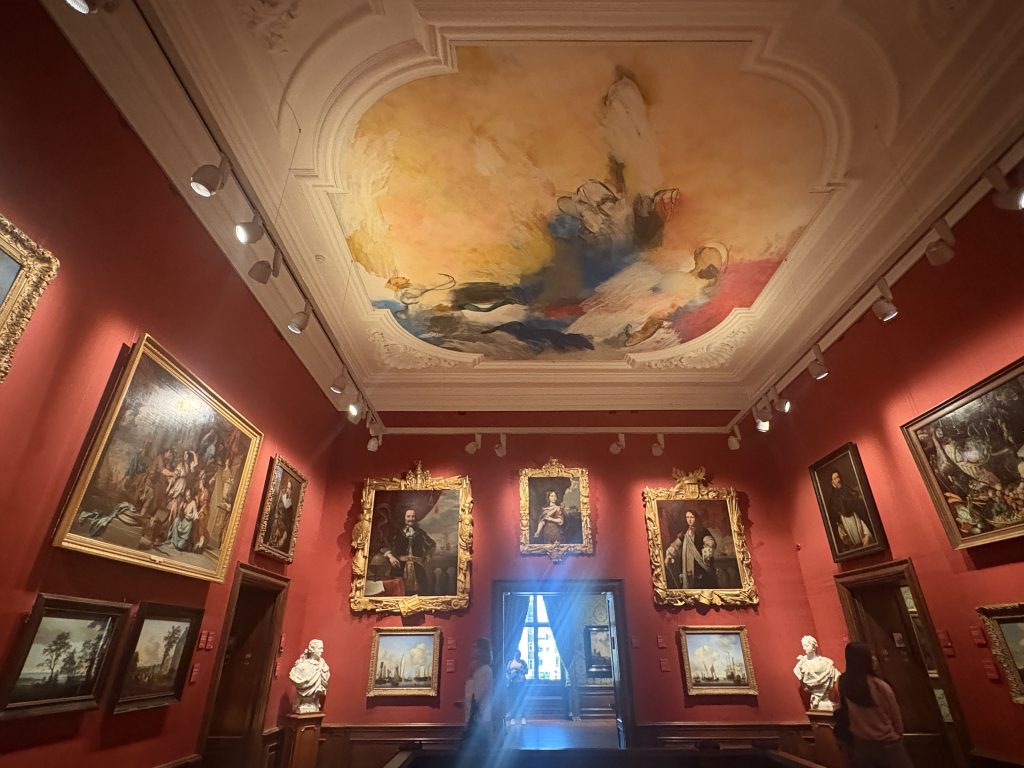
You then begin a joyful stroll through a world-class collection featuring some of the best of Dutch painting from the 16th and 17th centuries.
Here are some of my favorite pieces.
Still Life with Cheeses, Almonds and Pretzels by Clara Peeters
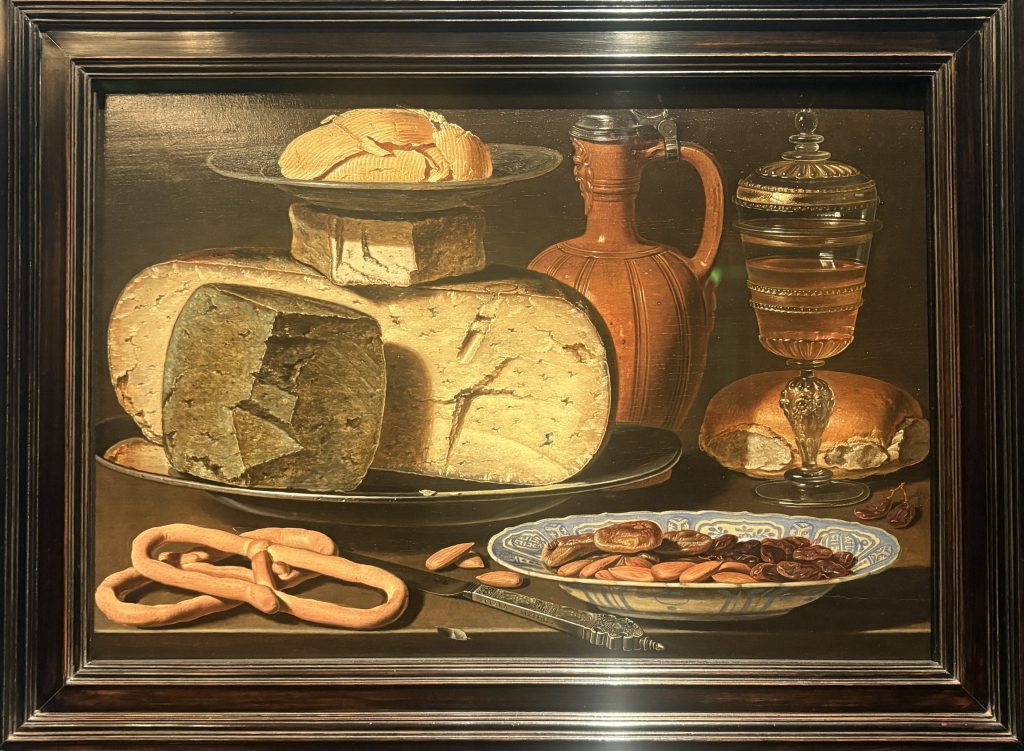
I’ve recently discovered the work of Flemish artist Clara Peeters, and I am smitten. She takes the still life genre to a whole new level with her stunning depictions of objects and food. From Antwerp, Peeters is one of the best-known female Flemish artists working professionally in the 17th century. She was well known for the depictions of still-life paintings with food.
The Mauritshuis exhibits at least two of her paintings. This one features bread and cheese, pretzels and almonds rendered with a precision and warmth that is mind boggling. And if you look really, really closely at the pewter rim of the jug, you’ll see a reflection of Clara’s face. How cool is that?
Check out the cracks in the large slab of cheese that dominates the picture and marvel at how she depicts the shine on the glass goblet. There is an elegance to Peeters’ work that is rare, even among the many still life painters of the period.
In a room full of other still life paintings, her work stands out by a mile.
Homer Dictating his Verses by Rembrandt
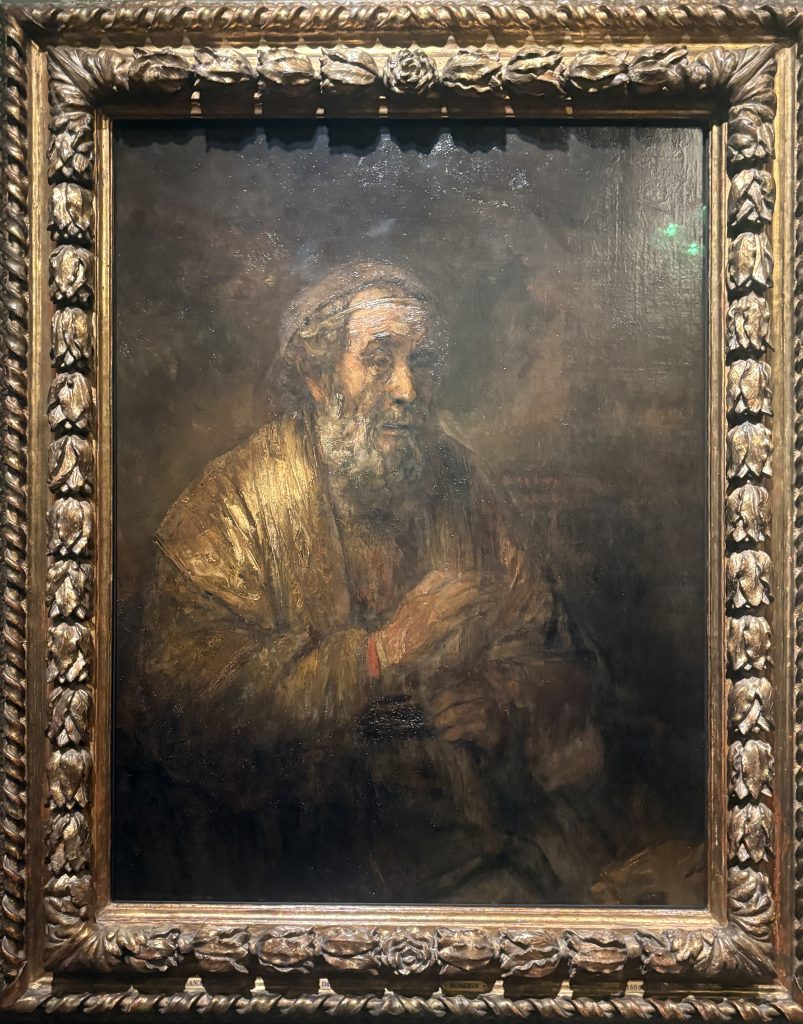
One entire room in the Mauritshuis is dedicated to displaying the work of Rembrandt, probably the most famous Dutch painter from the period. I was drawn to this painting as an excellent example of how Rembrandt excelled in the depiction of light and shadow.
The expression on Homer’s face is almost desperate, as if he knows he’s on his last legs and wants to dictate his stories before it’s too late. The way paint is so thickly applied to depict the folds and furrows of his face is almost modern. I’m strangely reminded of the work of Lucien Freud.
The room also features the large painting entitled Anatomy Lessons of Dr. Nicolaes, which is quite a bit more famous than the Homer one judging by the tour groups clustered in front of it.
Girl with a Pearl Earring by Johannes Vermeer

Johannes Vermeer, Public domain, via Wikimedia Commons
The Mauritshuis is home to one of the most famous paintings from the Dutch Golden Age: Girl With a Pearl Earring by Johannes Vermeer. She is undoubtedly the star of the show, and no wonder.
According to the Mauritshuis website, the painting is not a portrait, but a ‘tronie’, which is a painting of an imaginary figure or certain type of character. The girl is dressed exotically and wears a large (probably too large?) pearl in her ear. She looks over her shoulder at us, alluring and innocent at the same time.
I’ve been a Vermeer fan for years. He has quite the knack for capturing a moment in time that is poignant and also celebratory of the ordinary.
I’ve seen pictures of Girl with a Pearl Earring for decades (and read Tracey Chevalier’s marvelous novel) and wondered if seeing the real thing would be worth the trek to The Hague.
The answer? Absolutely! The “real thing” glows with a kind of internal power that cannot be duplicated. The color is more intense and yet more subtle than any reproduction. No wonder it’s mobbed!
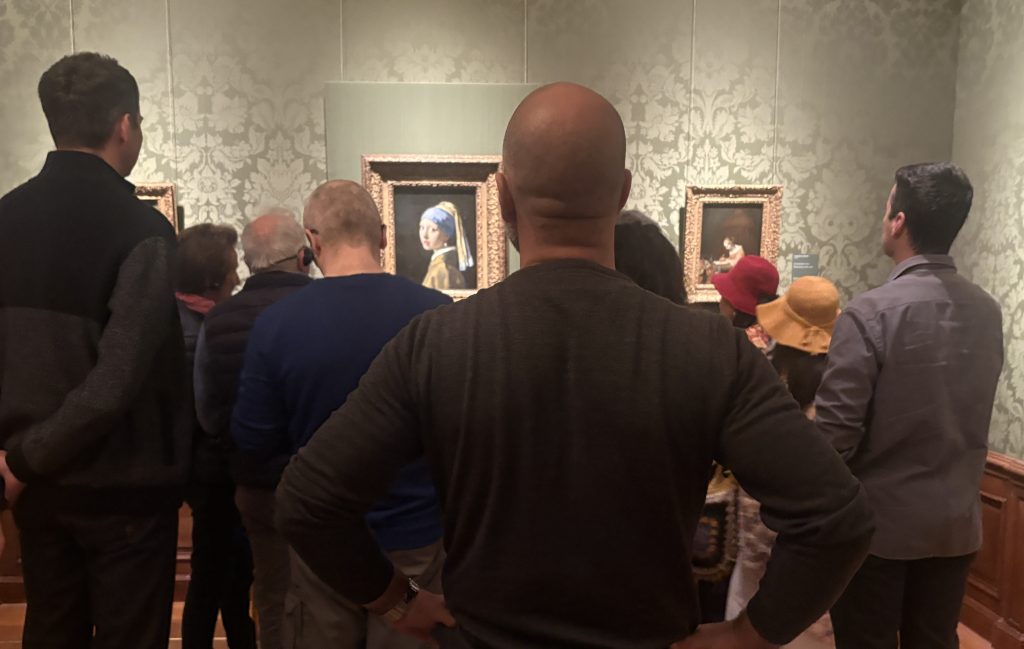
Man Offering Money to a Young Woman by Judith Leyster

Judith Leyster is another female artist from the period who is finally gaining the renown she deserves. The man is trying to buy her attention, but the woman works on, oblivious to his charms as she concentrates solely on her work.
The broad brushstrokes used by Leyster are very like those used by her most famous compatriot, Franz Hals. There is a looseness to her work that feels almost modern and very alive.
Kitchen Interior by David Teniers the Younger
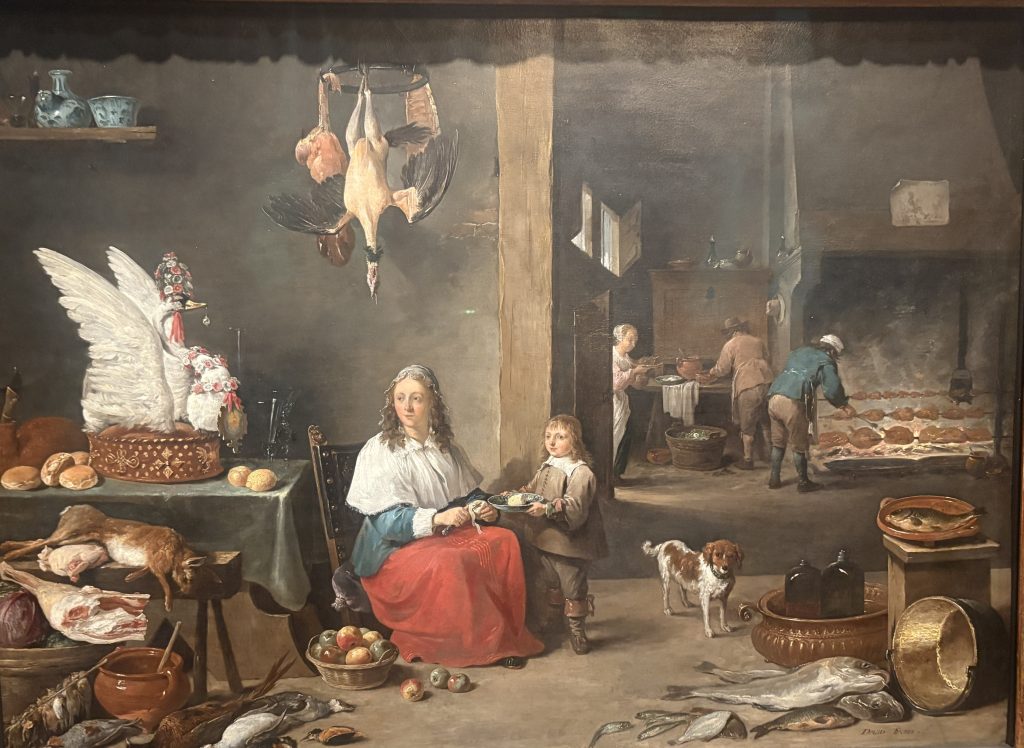
Some of my favorite paintings in the Mauritshuis are those depicting everyday life during the period. As an historical novelist, I really value these paintings as source material that give me a glimpse into what life was like back in the day.
This kitchen scene is replete with cool details, from the dead hare below the swan, the bowl of fruit, the mom looking exhausted as she peels apples, the boy holding the plate to receive the peeled apples and the dog in the middle of it all.
The various foods in the painting represent the four elements: the fish in the bottom right for water, the roasts in the background for fire, the game below the swan pie for earth, and the birds hanging above the woman for air.
Other Works in the Mauristhuis
Several other very famous works are included in the collection, including works by still life artist Rachael Ruysch (another one of my faves), Franz Hals, Peter Paul Rubens, and Jacob van Ruisdael, to name just a few.
You’ll also find The Goldfinch by Carel Fabritius.
As mentioned, one of the best things about this lovely gem of a museum is its compact size. While it’s chock-a-block full of great art, it doesn’t feel overwhelming. The rooms are small, the crowds very manageable, and there’s enough variety and famous images to keep you thoroughly engaged.
M. C. Escher in the Palace
Escher in the Palace is the second must-see museum in the Hague, especially for fans of the work of Maurits Corenlis Escher (AKA M. C. Escher), a 20th century master of perspective and illusion.
Never heard of Escher? Go the museum anyway! It’s very safe to say that anyone even remotely interested in art will be captivated by both the palace and its extensive collection of work by M. C. Escher.
It’s also a great place for kids, with some interactive displays and artwork that is sure to fascinate young minds.
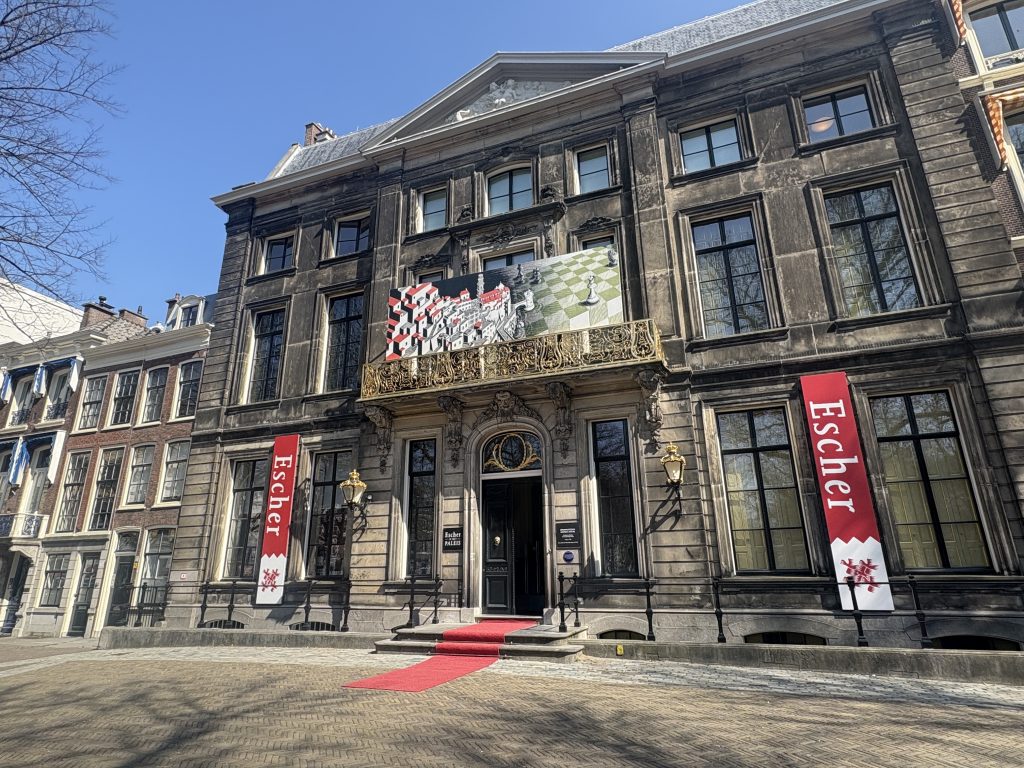
Overview of Escher in The Palace
Housed in the former palace of Queen Emma, the Queen Mother to Queen Wilhelmina, the museum is really a two-for-the-price-of-one attraction. Not only do you tour several rooms on three floors filled with Escher’s works, but you also get an insight into opulent royal life. On the Escher in the Palace website, you can take a virtual tour of the museum.
M. C. Escher’s works give new meaning to the term “optical illusion”. They are astonishing and very well known. You’re likely to have seen such masterpieces as Belvedere and Hand with Reflecting Sphere (see below), both of which have been extensively reproduced.
If you went to college in the 1970s or 1980s, you probably saw Escher prints on a dorm wall or two.
Getting Tickets for Escher in the Palace
You shouldn’t have any trouble just walking into the palace and purchasing tickets, but if you like to plan ahead, here’s an option from GetYourGuide:
https://www.getyourguide.com/the-hague-l1267/entrance-ticket-escher-in-het-paleis-t29651/
Favorite Works at Escher in the Palace
Following is an overview of a few of my favorite works in the collection. These are just the tip of the iceberg. You’ll find over 120 Escher prints in Escher in the Palace, enough to keep you fascinated for a good hour or more.
Belvedere
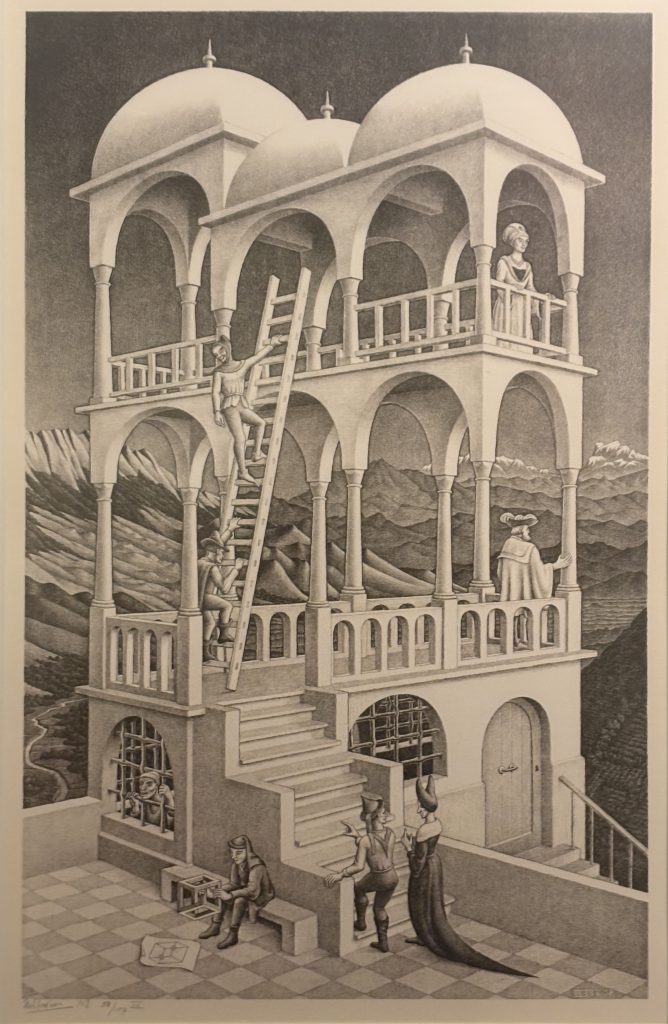
I once made the mistake of buying a jigsaw puzzle of this piece. It did not go well. Although the image looks like it would be easy to put together, it was not. I ended up doing something I almost never do: abandoning the puzzle and then giving it away.
Belvedere is one of the most famous examples of an Escher work showing a three-dimensional building that is drawn on a flat surface but cannot exist in real life. As you look at it, you’re challenged to figure out what is possible and what is not. You could spend a lot of time looking at this image and trying to trace your way up or down a staircase. Good luck!
Convex and Concave
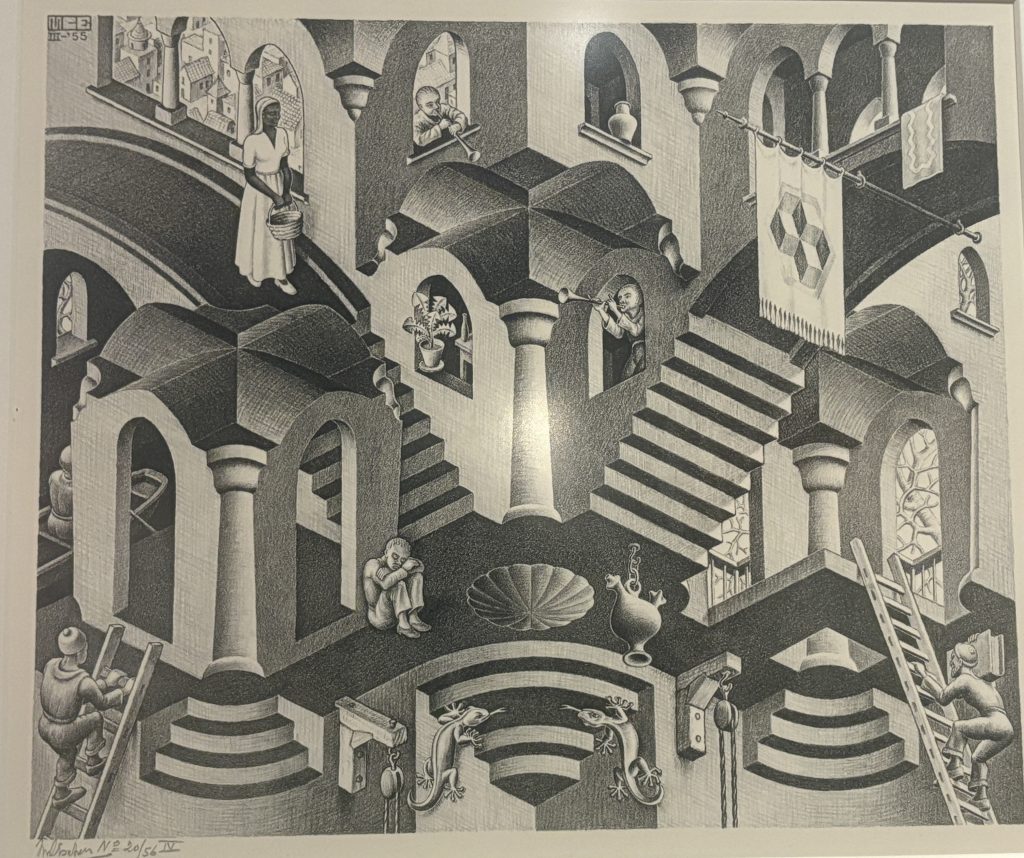
Here’s another eye twister that will keep you up at night. The image is Escher’s depiction of daily life in a Mediterranean town (never seen a town like this!).
On the left side, you look down on the life and on the right, you look up from below. It’s an impossible space, but it’s really hard to stop looking at it and trying to trace a way through.
Lizards

While I love Escher’s weird scenes and buildings, it’s Escher’s drawings of critters (particularly lizards) that really intrigue me. I could look at them for hours. The precision with which he renders the lizards and the way they overlap and interact is astonishing. You’ll also find plenty of other animal drawings, particularly of birds and insects.
Metamorphosis
Don’t miss the rooms containing some of Escher’s famous metamorphosis works. In these, Escher created a series of changing shapes, using many of his favorite forms such as reptiles, fish, insects, and birds.
A highlight is this large round piece in the center of one of the rooms. Walk around and around it to get the full effect and marvel at how Escher makes the transitions between forms so that you barely realize there is a transition until suddenly you’re looking at a fish when moments before you were looking at a horse.
Remarkable!
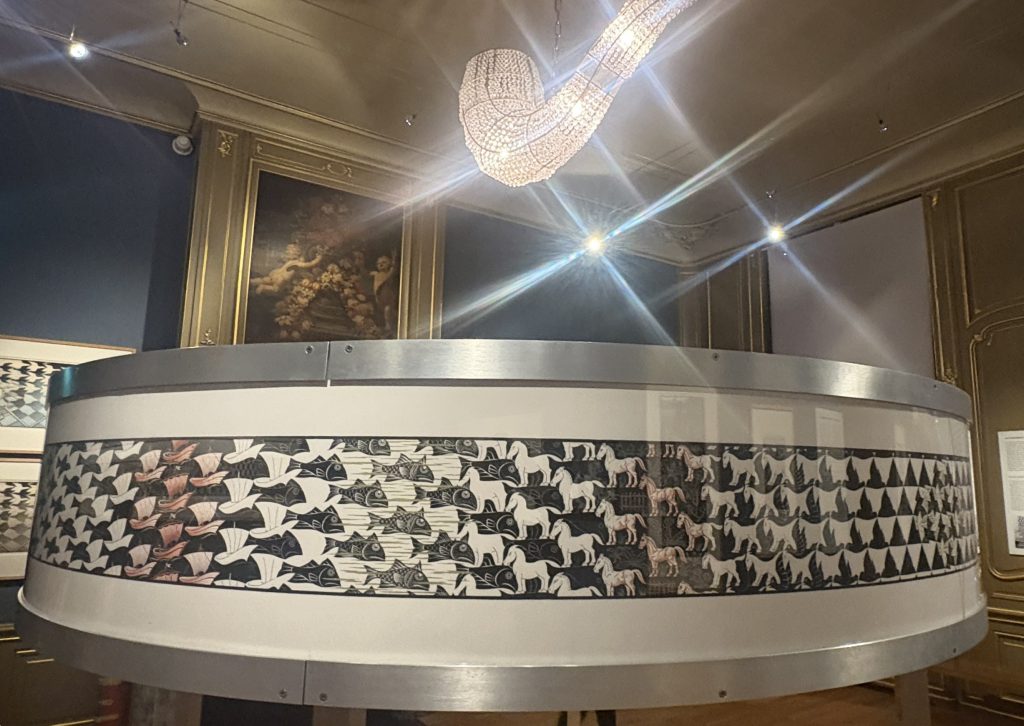
After you’ve toured Escher in the Palace, stop into the stylish gift shop. The attendants there were really friendly and helpful. I bought a gorgeous cashmere scarf, which I needed in the chilly April air. Note that the Netherlands is not particularly warm in the spring!

Staying in the Hague
I suggest staying in the city centre as close to the two museums as possible. I stayed at the Boutique Hotel Corona which was in an excellent location, although the room was a bit on the small side.
Other Attractions in the Hague
If you’re traveling with children, I highly recommend you go to Madurodam. I first visited way back in 1970s on my epic trip to Europe with my mom. We spent hours wandering around the miniature worlds. In the 1990s, I returned with my then-eight-year-old daughter who adored the place. The park has grown a lot since then with plenty of attractions to keep you engaged.
Here are a few tour options in The Hague from GetYourGuide:
Conclusion
Have you visited the Mauritshuis and Escher in the Palace in The Hague? What were some of the highlights for you? Please share in the comments below.
Here are more posts about awesome museums to visit in Europe:
- Best Three Must-See Museums To Visit in Copenhagen
- Seven Super Single-Artist Museums in Europe You Should Visit
- Best Vienna Museum Experiences that Appeal to the Artsy Traveler
- Courtauld Gallery in London: A Treasure Trove for the Artsy Traveler
